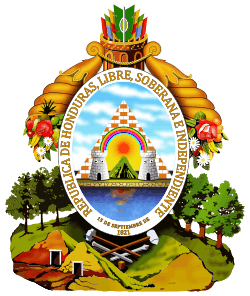Armed Forces of Honduras
The Armed Forces of Honduras (Spanish: Fuerzas Armadas de Honduras), consists of the Honduran Army, Honduran Navy and Honduran Air Force.
| Armed Forces of Honduras | |
|---|---|
| Fuerzas Armadas de Honduras | |
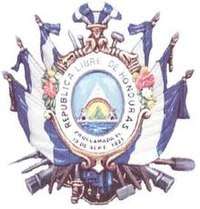 | |
| Founded | 1825 |
| Service branches | |
| Leadership | |
| Commander-in-Chief | Juan Orlando Hernández |
| Chief of the Armed Forces | General Tito Livio Moreno |
| Manpower | |
| Military age | 18 for voluntary 2–3-year service |
| Available for military service | 1,868,940[1] males, age 16–49, 1,825,770 (2008 est.) females, age 16–49 |
| Fit for military service | 1,397,938 males, age 16–49, 1,402,398 (2009 est.) females, age 16–49 |
| Reaching military age annually | 92,638 males, 88,993 (2009 est.) females |
| Active personnel | 52,225[2] |
| Expenditures | |
| Budget | $201,000,000[3] |
| Percent of GDP | 1.1% as of 2012[3] |
| Industry | |
| Foreign suppliers | |
| Related articles | |
| Ranks | Military ranks of Honduras |
History
Pre-1979
During the twentieth century, Honduran military leaders frequently became presidents, either through elections or by coups d'état. General Tiburcio Carías Andino was elected in 1932, he later on called a constituent assembly that allowed him to be reelected, and his rule became more authoritarian until an election in 1948.
During the following decades, the military of Honduras carried out several coups d'état, starting in October 1955. General Oswaldo López Arellano carried out the next coup in October 1963 and a second in December 1972, followed by coups in 1975 by Juan Alberto Melgar Castro and in 1978 by Policarpo Paz García.
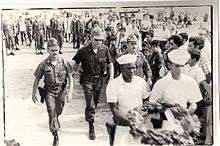
1980s
Events during the 1980s in El Salvador and Nicaragua led Honduras – with US assistance – to expand its armed forces considerably, laying particular emphasis on its air force, which came to include a squadron of US-provided F-5s.
The military unit Battalion 316 carried out political assassinations and the torture of suspected political opponents of the government during this same period. Battalion members received training and support from the United States Central Intelligence Agency, in Honduras, at U.S. military bases[4] and in Chile during the presidency of the dictator Augusto Pinochet.[5] Amnesty International estimated that at least 184 people "disappeared" from 1980 to 1992 in Honduras, most likely due to actions of the Honduran military.[6]
1990s
The resolution of the civil wars in El Salvador and Nicaragua, and across-the-board budget cuts made in all ministries, has brought reduced funding for the Honduran armed forces. The abolition of the draft has created staffing gaps in the now all-volunteer armed forces. The military is now far below its authorized strength, and further reductions are expected. In January 1999, the Constitution was amended to abolish the position of military commander-in-chief of the armed forces, thus codifying civilian authority over the military.
2000s
Since 2002, soldiers have been involved in crime prevention and law enforcement, patrolling the streets of the major cities alongside the national police.
2009
On 28 June 2009, in the context of a constitutional crisis, the military, acting on orders of the Supreme Court of Justice, arrested the president, Manuel Zelaya after which they forcibly removed elected President Zelaya from Honduras. See the article 2009 Honduran constitutional crisis regarding claims regarding legitimacy and illegitimacy of the event, and events preceding and following the removal of Zelaya from Honduras.
The military's chief lawyer, Colonel Herberth Bayardo Inestroza Membreño, made public statements regarding the removal of Zelaya. On June 30, he showed a detention order, apparently signed June 26 by a Supreme Court judge, which ordered the armed forces to detain the president.[7] Colonel Inestroza later stated that deporting Zelaya did not comply with the court order: "In the moment that we took him out of the country, in the way that he was taken out, there is a crime. Because of the circumstances of the moment this crime occurred, there is going to be a justification and cause for acquittal that will protect us."[8] He said the decision was taken by the military leadership "in order to avoid bloodshed".[9]
Human rights violations during 2009
Following the 2009 ouster of the president, the Honduran military together with other government security forces were allegedly responsible for thousands of allegedly arbitrary detentions[10] and for several forced disappearances and extrajudicial executions of opponents to the de facto government, including members of the Democratic Unification Party. However, evidence about these actions has yet to be provided and there has been some questioning in local media about the actual perpetrators, suggesting that they could actually be related to disputes within the leftists organizations themselves.[11][12][13][14][15][16]
Army
Land Bases
- 101 Brigada in Choluteca
- 105 Brigada in San Pedro Sula
- 110 Brigada in Danli
- 115 Brigada in Juticalpa
- 120 Brigada in Santa Rosa de Copan
Air Force
The FAH operates from four air bases located at:
- Hernan Acosta Mejia Air Base at Tegucigalpa
- Soto Cano Air Base at Comayagua,[17]
- Armando Escalon Espinal Air Base at San Pedro Sula
- Hector Caraccioli Moncada at La Ceiba.
With the exception of Soto Cano Air Base, all other air bases operate as dual civil and military aviation facilities.
Additionally, three air stations are located at:
- Catacamas
- Alto Aguán (bomb range)
- Puerto Lempira airstrips serve as forward operations locations-FOL.
Also a radar station operates at:
- La Mole peak.
Navy
The navy is a small force dealing with coastal and riverine security.
The navy has 31 patrol boats and landing craft.[18]
| Class | Origin | Type | Versions | In service | Fleet |
|---|---|---|---|---|---|
| Sa'ar 62-class offshore patrol vessel ((62 meters) 204-foot type) | Ocean Patrol Vessel | 1 | Delivered by Israel Shipyard and arrived in country December 2019 | ||
| Guaymuras class (105-foot Swift type) | Patrol boat | 3 | FNH 101 Guaymuras FNH 102 Honduras W/O FNH 103 Hibueras W/O | ||
| Yojoa (Hollyhock class) | Coastal buoy tender | 1 | FNH 252 Yojoa – ex-US Coast Guard Walnut W/O Broke in half during Hurricane Mitch | ||
| Punta Caxinas (149-foot Lantana type) | Coastal transport | 1 | FNH-1491 | ||
| Choluteca Class (65-foot Swift type) | Coastal patrol craft | 5 | FNH 651 Nacaome FNH 652 Goascoran FNH 653 Patuca FNH 654 Ulua FNH 655 Choluteca | ||
| Piraña class | Napco | Riverine ops boat | 8 | ||
| Boston Whaler Guardián Class | Riverine ops boat | 10 | |||
| Tegucigalpa Class (107-foot Lantana type) | Patrol boat | 3 | FNH-1071 Tegucigalpa[19] FNH-1072 Copán FNH-1073 Unknown name | ||
| Chamelecán Class (85-foot Dabur type) | Patrol boat | 1 | FNH-8501 | ||
| WARUNTA Class (73-foot LCM-8) | Landing craft | 3 | FNH-7301 Warunta FNH-7302 Rio Coco FNH-7303 Unknown name | ||
| LCU | 1 | ||||
| Small River Patrol Boat | 15 | ||||
| Golfo de Tribuga-class landing craft | Short Range Logistic Support Ship | BAL-C | 1 | FNH 1611 Gracias a Dios[20][21][22] | |
| Damen Stan Patrol Boat (140-foot 4207) | Coastal Patrol Vessel | 4207 | 2 | FNH 1401 Lempira – FNH 1402 Morazan | |
| Damen Stan Interceptor 1102 (36-foot) | Interceptor Boat | 1102 | 6 | ||
| Eduardoño Patrullero 320 (32-foot) | Interceptor Boat | 25 | FNH 3201 – 3225 | ||
| Boston Whaler Interceptors (20-foot) | Interceptor Boat | 10 | Unknown identification | ||
| Multi Mission Interceptor MMI35 (35-foot) | Interceptor Boat | 2[23] |
The Honduran navy has 4 naval bases:
- Base Naval Puerto Cortés – main repair and logistics base on the Caribbean Sea
- Base Naval Puerto Castilla – main operating base of patrol boats on the Caribbean Sea
- Base Naval Amapala – main operating base of coastal patrol craft on the north end of the island and only base on the Pacific Ocean side of Honduras
- Base Naval Caratasca – new base to deal with drug trafficking
Additionally, the Honduran navy has the following unit and schools:
- 1st. Marine Infantry Battalion – only marine unit located at La Ceiba
- Honduras Naval Academy – Trains officers for the Honduras Navy at La Ceiba
- Naval Training Center – NCO and Sailor training facility
Military-civilian relations and leadership
According to a statement in July 2009 by a legal counsel of the Honduras military, Colonel Herberth Bayardo Inestroza, part of the elite Honduran military generals were opposed to President Manuel Zelaya, whom the military had removed from Honduras via a military Coup d'état, because of his left-wing politics. Inestroza stated, "It would be difficult for us [the military], with our training, to have a relationship with a leftist government. That's impossible."[8]
The current head of the armed forces is Carlos Antonio Cuéllar, graduate of the General Francisco Morazan Military Academy and the School of the Americas. In January 2011, the General Rene Arnoldo Osorio Canales former head of the Presidential Honor Guard, was appointed Commander.
As of 2012 the Honduran Military has the highest military expenditures of all Central America.
Equipment
Hand guns
- Beretta 92FS
Sub machine guns
- Mini Uzi
Rifles
Rocket launchers
- 120x Carl Gustav recoilless rifle[24]
- 80x M40 recoilless rifle[25]
- M72 LAW[25]
- M203
- RPG-2
- RPG-7
- Heckler & Koch HK69A1 Used by Honduran Army Special Forces.
- Mk 19 grenade launcher Used by Honduran Army since 2013, donated by the United States for anti-narcotics operations.
Vehicles and artillery
| Image | Name | Origin | Type | Number | Notes |
|---|---|---|---|---|---|
 | Scorpion | Light tank | 19 | FV-101\76 76mm main gun. | |
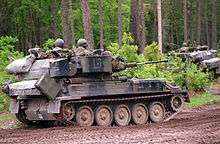 | Scimitar | Armoured Recce tank | 3 | FV-107 30mm main gun. | |
 | Sultan | Command Vehicle | 1 | FV-105 | |
 | Humvee | APC 4x4 | 30 | M40 106mm RCL. | |
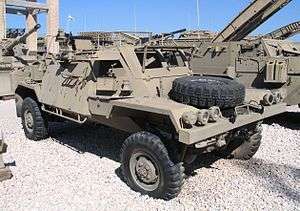 | RBY MK 1 | Reconnaissance Vehicle | 16 | M40 106mm RCLs. | |
.jpg) | Saladin | Armoured Car | 72 | FV-601. 6x6 76mm main gun. |
| Image | Name | Origin | Type | Number | Notes |
|---|---|---|---|---|---|
| M151 | Light Utility Vehicle | unknown | |||
| Jeep J8 | Light Utility Vehicle | unknown | |||
 | M35 | 6x6 Cargo Truck | unknown | ||
| Ford F-Series Truck | F-250 4x4 Truck | unknown | |||
| Ashok Leyland Stallion | 4x4 Truck | 110 | Ordered in January 2009. Part of an order for 139 miscellaneous utility and transport vehicles.[27] | ||
| Ashok Leyland Topchi | 4x4 Truck | 28 | Ordered in January 2009. Part of an order for 139 miscellaneous utility and transport vehicles.[27] | ||
| L-series | 4x4 Truck | Various | Some to be replaced for Ashok Leyland Stallion. | ||
| Mercedes Benz Unimog | 4x4 Truck | Various | To be replaced for Ashok Leyland Stallion. |
| Image | Name | Origin | Type | Number | Notes |
|---|---|---|---|---|---|
 | M102 | Towed 105mm Howitzer | 24 | ||
 | M101 | Towed 105mm Howitzer | 20 | ||
_001.jpg) | M198 | Towed 155mm Howitzer | 12 | ||
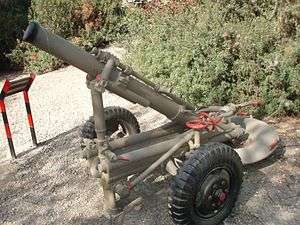 | M-66 | 160mm Mortar | 30 | ||
 | M-65 | 120mm Mortar | 30 | ||
| Brandt | 120mm Mortar | 60 | |||
| M55A2 | 20mm Anti-Aircraft Gun | 80 | 34 in service. | ||
 | M167 VADS | 20mm Anti-Aircraft Gun | 30 | ||
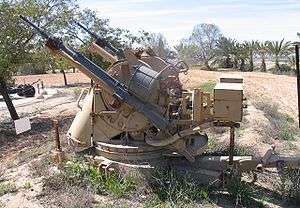 | TCM-20 | 20mm Anti-Aircraft Gun | 24 |
See also
- Honduran presidential plane
References
- "CIA World Factbook".
- "NationMaster.com".
- "Stockholm International Peace Research Institute (SIPRI)". Archived from the original on 2015-01-04.
- Cohn, Gary; Ginger Thompson (1995-06-11). "When a wave of torture and murder staggered a small U.S. ally, truth was a casualty". Baltimore Sun. Archived from the original on 2011-05-22. Retrieved 2009-07-27.
- Equipo Nizkor, LA APARICION DE OSAMENTAS EN UNA ANTIGUA BASE MILITAR DE LA CIA EN HONDURAS REABRE LA PARTICIPACION ARGENTINO-NORTEAMERICANA EN ESE PAIS., Margen (in Spanish)
- "Honduras: Still waiting for justice". Amnesty International. 1998. Retrieved 2009-07-27.
- Lacy, Marc (July 1, 2009). "Leader's Ouster Not a Coup, Says the Honduran Military". The New York Times. Retrieved July 3, 2009.
- English summary of interview with the legal counsel of the Honduras armed forces, Colonel Herberth Bayardo Inestroza, Robles, Frances (2009-07-03). "Top Honduran military lawyer: We broke the law". Miami Herald. Archived from the original on 2009-09-06. Retrieved 2009-09-06.; original Dada, Carlos; José Luis Sanz (2009-07-02). "Cometimos un delito al sacar a Zelaya, pero había que hacerlo (" (in Spanish). El Faro.net, El Salvador. Archived from the original on 2009-09-06. Retrieved 2009-09-06.
- "Ejército de Honduras reconoció que cometió un delito al sacar a Zelaya". www.cooperativa.cl (in Spanish). Compañía Chilena de Comunicaciones S.A. Retrieved 2009-07-05.
- "Preliminary Observations on the IACHR Visit to Honduras". Inter-American Court of Human Rights. 2009-08-21. Archived from the original on 2009-08-30. Retrieved 2009-08-26.
- "Informe Preliminar Violaciones A Derechos Humanos En El Marco Del Golpe De Estado En Honduras". Comité de Familiares de Detenidos Desaparecidos en Honduras. 2009-07-15. Archived from the original on 2009-10-29. Retrieved 2009-07-30.
- "International Observation Mission for the Human Rights Situation in Honduras Preliminary Report – Confirmed systematic human rights violations in Honduras since the coup d'etat". Upside Down World. 2009-08-06. Archived from the original on 2009-08-09. Retrieved 2009-08-09.
- Pérez, Luis Guillermo; et al. (2009-08-06). "Gobierno de facto viola derechos humanos" (in Spanish). Agencia Latinoamerica de Información. Archived from the original on 2009-12-03. Retrieved 2009-08-26.
- "International Mission denounces the brutal repression of pacific demonstrations". Agencia Latinoamerica de Información. 2009-07-30. Archived from the original on 2011-07-24. Retrieved 2009-08-02.
- Quixote Center Emergency Delegation of Solidarity, Accompaniment and Witness (2009-08-07). "Letter to Honduran Attorney General Rubi". Quixote Center. Archived from the original on 2010-11-27. Retrieved 2009-08-09.
- Human Rights Watch (2009-08-25). "Honduras: Rights Report Shows Need for Increased International Pressure". Human Rights Watch. Archived from the original on 2009-08-28. Retrieved 2009-08-28.
- "Academia Militar de Aviación". Archived from the original on 2009-04-18.
- CDR John T. Nawrocki, USN. "Charting A Course for the Future: The Honduran Naval Forces" (PDF). Defense Institute of Security Assistance Management. Cite journal requires
|journal=(help) - "FNH 1071 Tegucigalpa UNITAS 2016". www.infodefensa.com.
- "Cotecmar entregó a la Fuerza Naval de Honduras el buque logístico FNH 'Gracias a Dios'". www.webinfomil.com.
- "Honduras firma contrato con COTECMAR para la construcción de buque naval". COTECMAR.
- "Colombia, Honduras sign contract for COTECMAR vessel". IHS Jane's 360.
- http://www.webinfomil.com/2018/10/la-fuerza-naval-de-honduras-bote-interceptor-mmi35.html
- "country-data.com > Honduras > Appendix".
- Jane's World Armies 2008. Jane's Information Group. p. 318.
- Jane's Infantry Weapons 2007–08. Jane's Information Group. p. 876.
- "A$10.5 million order for Ashok Leyland from Honduras". Machinist.in. 16 January 2009. Retrieved 5 July 2009.
